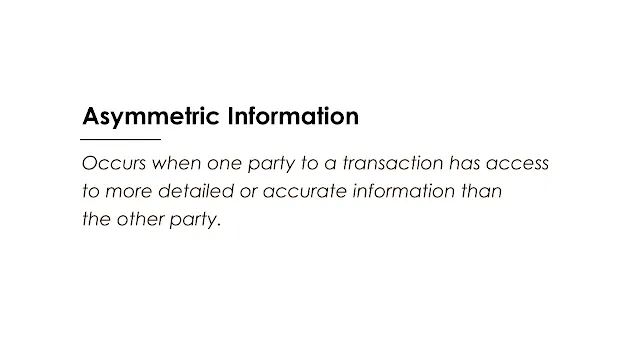 |
| Image: Moneybestpal.com |
Asymmetric information occurs when one party to a transaction has access to more detailed or accurate information than the other party. As a result, there may be an imbalance of power that leads to market inefficiencies or unfair results. In many different settings, including the insurance, finance, health care, education, and labor markets, asymmetric information might exist.
A supplier knowing more about a product's quality than a consumer is an example of asymmetric information. This can lead to moral hazard, where the seller has an incentive to conceal or misrepresent the genuine quality of the goods, or adverse selection, where the customer ultimately purchases a low-quality product at a high price. A secondhand automobile salesperson, for instance, might be aware of a car's concealed flaws but decide not to tell the prospective buyer. The purchaser might then fork over more money than the vehicle is worth or deal with future expensive repairs.
Another example of asymmetric information is when a borrower knows more about their ability or willingness to repay a loan than a lender. Moreover, this may lead to moral hazard, where a borrower is enticed to take on additional risk or commit fraud after getting the loan, or adverse selection, where the lender draws in clients who are more likely to default. A bank might lend money to a company that says it has a profitable idea, but the company may actually use the funds for a risky enterprise or divert them to other uses. If the business defaults on the loan, the bank can potentially sustain losses.
Asymmetric information can have detrimental effects on both society and individuals. It may prevent some mutually beneficial transactions from happening or cause some resources to be allocated to less productive uses, which can lower the market's efficiency and welfare. Also, it can lead to inequity and injustice because certain agents may make use of their informational advantage over rivals to their detriment.
Asymmetric information does, however, provide a few potential fixes or treatments. Many of them include:
- Signaling: In order to divulge their personal information or quality, one side must give a convincing signal to the other party. To demonstrate the dependability of their product, a vendor can issue a warranty or a guarantee, while a borrower might show their creditworthiness by offering collateral or references.
- Screening: This occurs when one party researches the other party before entering into a deal. For instance, a buyer might examine or test a product before purchasing it, or a lender might research a borrower's income or credit history before approving a loan.
- Regulation: To eliminate asymmetric information and safeguard the interests of customers or investors, a third party, such as the government or an agency, enforces norms or standards. For instance, the government may mandate that vendors reveal pertinent details about their goods or services, such as ingredients, safety precautions, or effects on the environment, or it may regulate the financial markets to thwart manipulation or fraud.
- Reputation: This is the process through which one party establishes a reputation over time based on their performance or behavior in the past. This can lessen knowledge asymmetry and improve party collaboration and trust. A borrower may develop a reputation for timely loan repayment, much as a seller may do if they provide high-quality goods or offer exceptional customer service.
Asymmetric information is a key idea in economics that helps to explain why some markets may fail or perform ineffectively. Our ability to create better institutions and policies to address its issues and enhance social welfare depends on our ability to comprehend its causes and effects.
